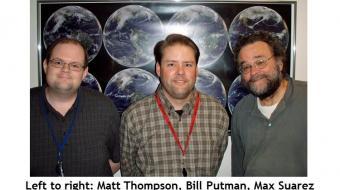 CUDA Spotlight: Bill Putman, NASA by Nadeem Mohammad, posted Mar 12 2012 at 03:07PM CUDA Spotlight: GPU-Accelerated Climate Simulation This week's Spotlight is on William Putman, a NASA research meteorologist in the Global Modeling and Assimilation Office (GMAO) in the Earth Sciences Division of Goddard Space Flight Center's Sciences and Exploration Directorate. NVIDIA: Bill, what does your group do? To achieve this goal, the GMAO develops models and assimilation systems for the atmosphere, ocean, and land surface, generates products to support NASA instrument teams and the NASA Earth Science program, and undertakes scientific research to inform system development pathways. Within the GMAO we have a group of developers (Dr. Max Suarez, Dr. Matthew Thompson and myself) tasked with the restructuring of NASA’s Goddard Earth Observing System atmospheric general circulation model version 5 (GEOS-5) to take advantage of new accelerator technologies including GPUs. NVIDIA: What is the main focus of your work? NVIDIA: What role does GPU computing play? The excitement surrounding these preliminary groundbreaking simulations has created a drive toward enhanced understanding of the processes now capable of being resolved, a desire that drives the need for faster turnaround of these results and contention for limited computational resources. GPU computing presents an opportunity for improving the efficiency of these leading edge Earth system simulations. GPUs also offer the opportunity to greatly increase the accessibility of Earth system models to more people. Today’s workhorse climate models, running at resolutions of 100 to 200 km, may be capable of lengthy simulations on desktop GPU-based systems available to individual researchers, not just major centers. We believe a GPU implementation of GEOS-5 will facilitate the use of cloud-system resolving resolutions in data assimilation and weather prediction, improve the throughput for the intermediate resolution models used in climate prediction and assessments, and increase the usability and accessibility of the models used in academic research by making possible a coarse resolution version of GEOS-5 (essentially a climate prediction capability) on a small box of GPUs. NVIDIA: Why is cloud-system resolving important? NVIDIA: What are the benefits of using CUDA? Like CUDA C, CUDA Fortran allows for low-level management of the initialization, data transfer, and coding details of a project without the need to translate legacy Fortran code into C. This aids both in speed of development and with keeping a readable (to developers) codebase within GEOS-5 while achieving much the same performance as CUDA C. Note that our work with GPUs is being done directly within our development path concurrent with our CPU development. This is being done with the least intrusion on the CPU code as possible, while maintaining minimal disruption to the end-users of GEOS-5. This means our make systems support both CPU and GPU builds alike, and our CPU results remain bitwise identical. As a result, formal releases of GEOS-5 contain GPU capable codes. We have begun to use our GPU implementation to evaluate climate simulations with GEOS-5 and perform idealized dynamical core test cases with a GPU capable finite-volume dynamical core. NVIDIA: What future applications can you envision? Bio: He received his PhD in meteorology from the Florida State University in 2007 for the implementation of the finite-volume dynamical core on the cubed-sphere geometry. The extension of the finite-volume numerics to the cubed-sphere geometry poises the finite-volume dynamical core for application on emerging peta-scale systems over the next 5-10 years by allowing efficient execution on tens to hundreds of thousands of computational processors. He is involved on numerous inter-agency efforts to implement advanced dynamical algorithms for global earth system modeling, and has collaborated with various institutions including the NOAA Geophysical Fluid Dynamics Laboratory on the non-hydrostatic finite-volume cubed-sphere dynamical core, the NASA Goddard Institute for Space Sciences ModelE general circulation model, and the Community Atmospheric Model (CAM) at the National Center for Atmospheric Research. Relevant Links: Contact Info: |